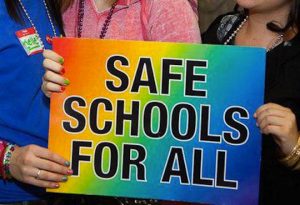Academic Literature on the Issue: A Synthesis of Two Peer-Reviewed Articles
In the tenuousness of our current political era, numerous scholars and activists have written content on the experiences of marginalized youth, including trans kids in public school settings. Below I explore the research of Wernick et al. and Beese and Martin; both groups recently published articles that discuss the experiences of trans students in school.

autostraddle
Background
In 2017, the Trump administration revoked protections for trans students in schools that were created during the Obama era. As such, transgender students are facing continuous persecution. Both Wernick et al. and Beese and Martin discuss that trans kids have few legal protections, and face being gendered incorrectly, referred to with their incorrect name, and can be forced to use bathrooms and lockers that do not match their gender identity. Both articles use bathroom access as an entry point to understand the widespread inequality that transgender students face in school when compared to their straight peers.
Marginalization of Trans Kids in School
According Wernick’s 2017 climate survey of trans students, a school’s general sense of equality and inclusivity for trans kids can be indicated by trans students’ sense of safety using the bathroom (Wernick et al., 928). Similarly, Beese and Martin article use the legal struggles of a trans teenager named Bobby to demonstrate the importance of bathrooms in establishing an overall sense of trans safety and inclusivity in school (Beese and Martin, 65). Both emphasize the importance of inclusive, gender-affirming bathrooms in order to foster a broader school culture of tolerance and respect.
Wernick’s study used safety, self-esteem, and grades as three measures to determine overall wellbeing of students in school. According to their research, a students’ sense of safety using the bathroom predicts their overall wellbeing. When a transgender student does not have access to the correct bathrooms, they are more likely to have poor grades and low self-esteem (Wernick et al., 917). Overall, trans students’ education suffers when they do not exist in a gender-affirming educational community. What this research indicates is that bathrooms are a crucial first step in establishing a trans-inclusive school environment, and without this inclusivity, trans students’ grades and mental health suffer.
Recommendations for Better Trans-Inclusive School Policies
Both Wernick et al. and Beese and Martin outline numerous recommendations for creating schools that allow trans students to not only feel safe, but also thrive in their pursuit of education. According to Beese and Martin, districts need to take active steps toward making their schools trans-inclusive, rather than waiting until a family sues for civil rights violations, as was the case in Bobby’s school (Beese and Martin, 66). Some steps they outline for creating a trans-inclusive school include using preferred names on all rosters, attendance sheets, IDs, awards, and so on, and also exercising extreme caution in releasing a student’s private information (such as legal name or sex assigned at birth) (Beese and Martin, 70). They recommend consulting the district’s attorney about students’ rights as outlined under Title IX, The Family Educational Rights and Privacy Act (FERPA), and the First Amendment. These changes and preventative measures should be combined with inclusive pedagogy, gender/LGBT education, and unrestricted access to the correct bathrooms, locker rooms, and other gendered facilities (Beese and Martin, 71). According to Wernick et al., a school environment that is inclusive of all gender experiences not only improves outcomes for transgender and queer students, but cisgender and straight students as well (Wernick et al., 927). Thus, districts should prioritize LGBT inclusivity in order to maximize the outcomes of all students, not just transgender students.
